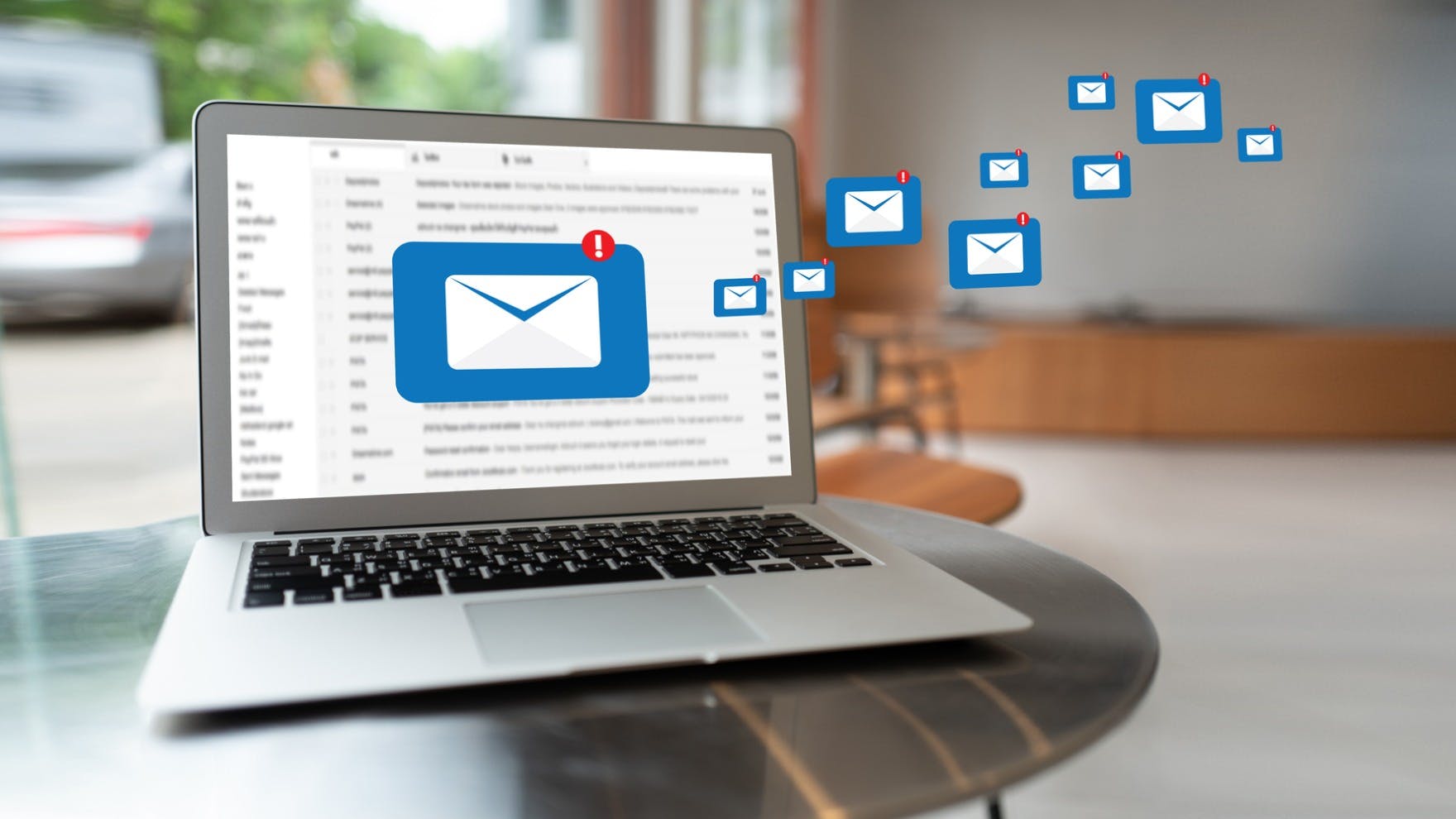Email Outreach Guide: Tips, Templates, & Tools to Succeed
Jenny Keohane
Email outreach is a powerful prospecting technique for generating leads and filling your pipeline.
With the rise of emails sent and received each year, sales reps should regularly re-evaluate techniques and strategies to stay on top of current trends.
It’s no secret that in 2022, your outreach needs to be more targeted and personalized than ever before.
In this guide, we look at various aspects of email outreach: what recent data tells us, current best practices, data trends, successful email templates, and more.
Here’s what we’ll cover:
- What Is Email Outreach?
- Why Is Email Outreach Important?
- Prospecting: How to Get Started
- How to Write Effective Email Outreach
- Email Templates
- Following Up
- Email Outreach Best Practices
- Email Outreach Mistakes
- Email Outreach Tools
What Is Email Outreach?
Email outreach is the process of sending emails to recipients in hopes of them taking a specific action. Sales reps reach out to potential customers with the hopes of building a relationship and ultimately closing a mutually beneficial deal.
Many elements tie into an effective outreach email, such as the subject line, introduction, personalization, closing, and CTA. We’ll cover all of this and more below.
Cold Emails vs. Warm Emails
There are two main types of email outreach in sales: cold emails and warm emails.
A cold email is an email sent to someone you haven’t had any prior contact with and there is no prior relationship.
A warm email is an email sent to someone who has shown interest in your product/service and whom you’ve had prior contact with, whether that be through your website, social media, blog, etc.
It’s pretty apparent which outreach is most effective. But when generating leads, you can warm up cold leads yourself, such as engaging on social media and offering value.
Why Is Email Outreach Important?
Email outreach is important because when leads dry up, sales reps can take matters into their own hands to help fill their pipeline by initiating contact and generating interest.
If you can excel at communicating the benefit of your product or service through highly targeted and personalized outreach, you can convert leads into customers at high rates. This can have a tremendous impact on your bottom line.
In fact, studies show that outbound sales tactics are a critical component of a successful sales strategy; the sweet spot is using a combination of both.
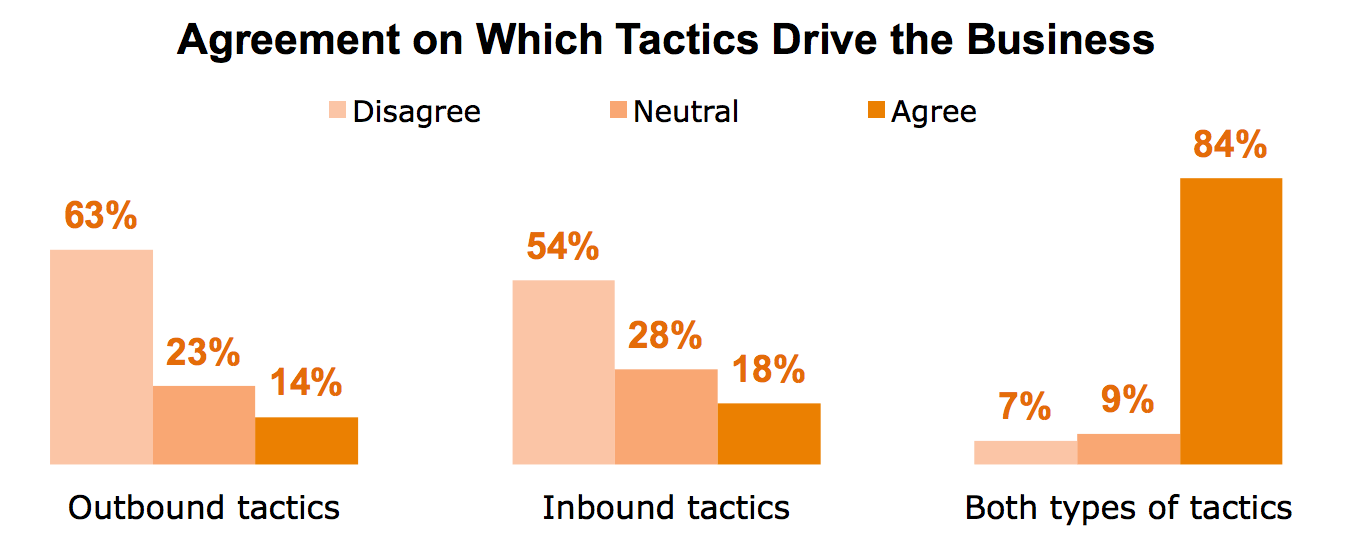
With outbound sales, you don’t wait around for the customer to come to you.
You proactively reach out to your ideal customers with highly targeted messaging that leads to strong customer relationships and more business opportunities.
Prospecting: How to Get Started
Sales prospecting is the process of finding potential customers for your product or service. This includes reaching out to leads through email outreach, social media, cold calling, etc., in the hope of creating sales opportunities.
Prospecting also includes ensuring you find the right leads. This requires a strong lead qualification process to determine good fits vs. time-wasters.
In order to start your email outreach, you need to find leads who truly need your product/solution to solve their problems.
Develop Personas
The first step to finding your best leads is identifying your ideal customer. Your ideal customers bring the most economic benefit to your business. They move through the sales cycle quickly and have a high customer lifetime value.
In order to identify these ideal customers, it’s necessary to build a buyer persona, also known as a sales persona. This is a detailed profile of someone who represents your target customer.
A buyer persona outlines the most important demographics, characteristics, and influencing factors about the decision-makers in your target market.
Here are some important elements to include in your persona template:
- Professional Demographics: role titles, daily responsibilities, tenure, and career aspirations.
- Personal Demographics: salary, location, gender, age, family makeup, etc.
- Firmographics: company’s size, revenue, growth rate, and employee demographics.
- Purchasing and Online Behavior: recent purchasing behavior and the tools they’ve already invested in.
- Goals: professional goals, KPIs, and important metrics.
- Challenges and Pain Points: biggest challenges, fears, motivators, and other emotional drivers.
Here’s an example of a buyer persona template:

Find Email Addresses
There are various ways to find email addresses. Here are some tools for doing so:
- Yesware
- Hunter.io
- Clearbit
- Leadfuze
- Voila Norbert
- Email Permutator
You can also use LinkedIn for this. In LinkedIn’s advanced settings is the ability to export your connections, giving you an up-to-date email address in your inbox.
Here’s how to do it:
- Click “Me” at the top of your LinkedIn homepage.
- Select “Settings & Privacy” from the dropdown.
- Under “Data Privacy,” click the tab “How LinkedIn uses your data.”
- Next to “Get a copy of your data,” click “Change.”
- Select “Want something in particular? Select the data files you’re most interested in.”
- Click “Connections” and “Request Archive.”

Once doing so, you’ll receive an email in about 10 minutes with a spreadsheet/CSV file with your connections’ information. The spreadsheet includes their name, email address, company, and position.
How to Write Effective Email Outreach
1. Compelling Subject Line
For such a small word count, your email subject line will either make or break your email. Why? This is the first thing recipients see when your email lands in their inbox. And it’s ultimately the deciding factor of whether they open your email or not.
Although there’s no “golden principle” to creating the perfect subject line, there is data to help guide you in the right direction. Here are some of our favorite findings on subject lines.
Use Numbers in Your Subject Lines
In a cold email subject line study conducted by Yesware, we found that subject lines that include numbers get a 45% higher open rate than the average open rate.
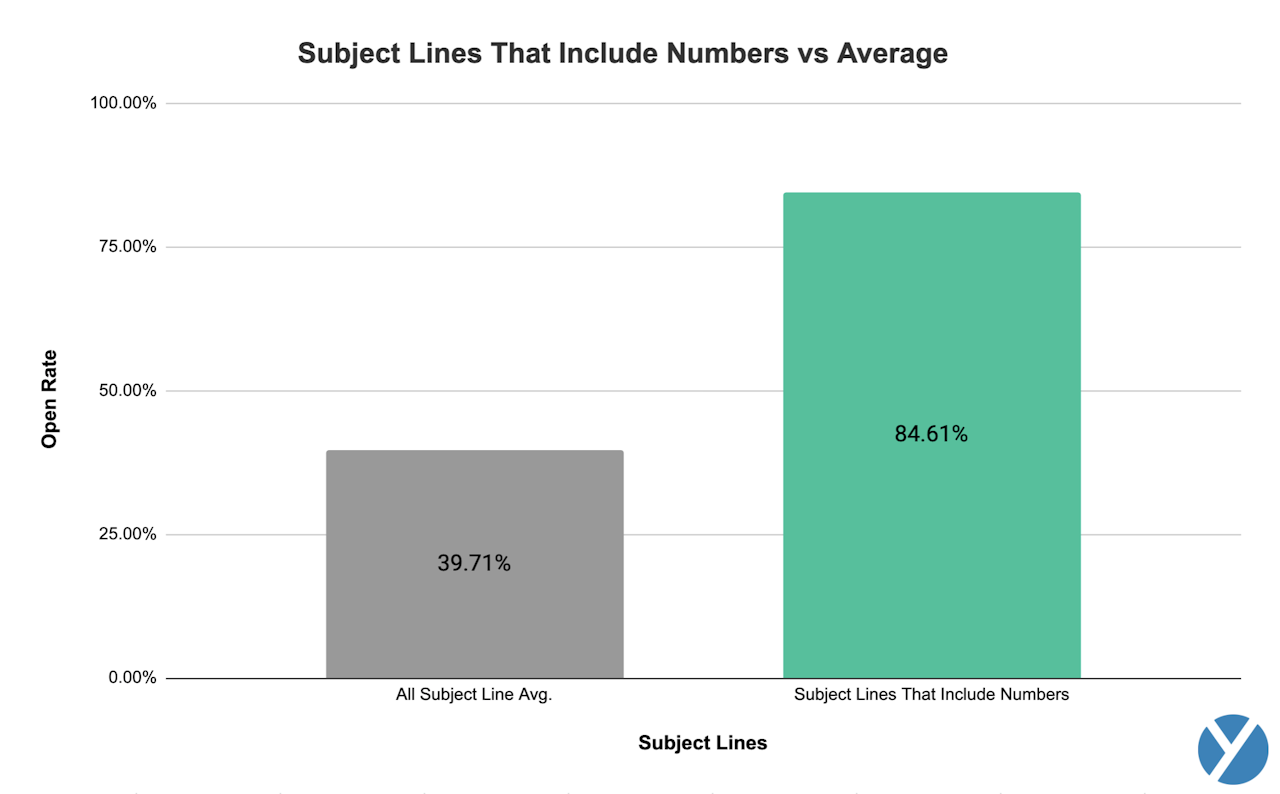
Appeal to Emotion
It’s simple; emotion drives us to react. When you generate emotion in your subject lines, the reaction is an email open. And when you address this emotion in the email itself, the desired reaction is a reply.
Some of the best techniques for appealing to emotion in your subject lines are curiosity (get them wanting more), empathy (build connection), and FOMO (nobody likes to feel left out).

Personalize Your Subject Lines
Every subject line study out there recommends you personalize your subject lines. Why? No recipient is the same; just like you need to personalize your email outreach, your subject line falls into the same category.
If you make it known you’re writing for them rather than your entire email list, they’ll be much more inclined to open your email.
Ask Questions
In our cold email subject line study, we also found that subject lines that are questions get about 10% more open rates than the average open rate.
This ties into appealing to emotion. As humans, when presented with a question, we develop an urge to know the answer. This is why questions are so powerful for generating opens.

Keep It Short
Keep your subject lines clear and concise. In an email template study, we found that the most successful emails (for both opens and replies) had subject lines between 1-5 words.

When one subject line doesn’t work, make sure you use a different approach in your follow-up email subject lines.
2. Professional Salutation
When sending professional emails, pay attention to how you address your recipients.
Your greeting is your recipient’s first impression of you, so play it safe.
Grammarly suggests the six best ways to start an email are:
- Hi [Name],
- Dear [Name],
- Greetings,
- Hi there,
- Hello, or Hello [Name],
- Hi everyone,
3. Strong Opening
In order to engage your readers right off the bat in your email outreach, you need to have a good opening.
It’s easy to start your email talking about yourself. But that’s not relevant to your prospect or their problems. And it’s a sure path straight to the trash folder.
How do you make your email introduction resonate with your recipients? Make it about them.
A great way to show you’ve done your research and start your email on a positive note is to congratulate them on a recent accomplishment. Starting your email off with this will help build rapport right from the get-go.
You can ensure you always have a custom sentence about the prospect by building this into your research cadence.
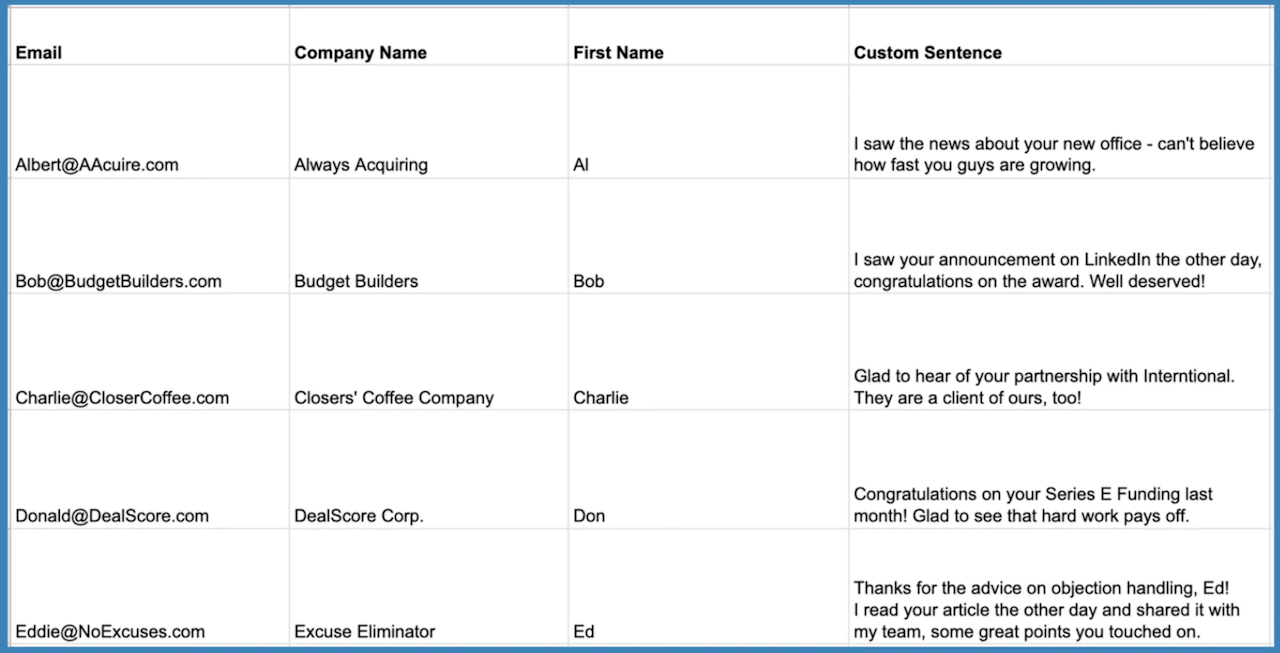
Here are some examples:
- “I saw your post about _____”
- “I noticed you manage _____”
- “Congratulations on _____”
- “Great insights on _____”
- “I’m inspired by the work you’ve done on _____”
Who doesn’t like reading about themself? They’ll have a more positive impression of you right off the bat.
4. The Perfect Pitch
The best way to pitch your product or service in 2022 is to act as a trusted advisor.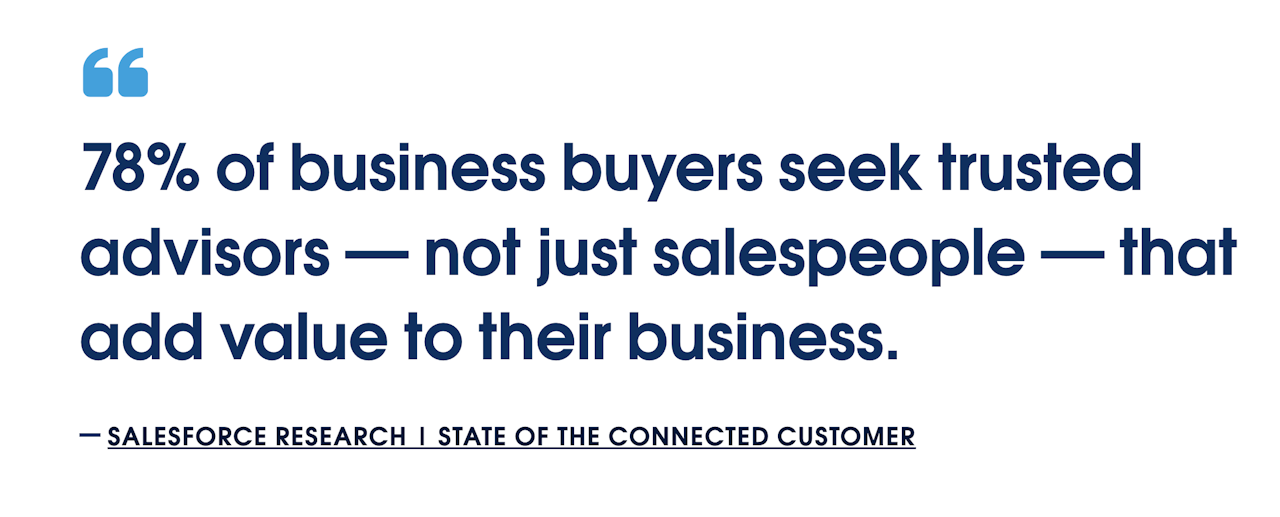 By taking a more consultative selling approach, you center your sales pitch around the customer and their needs.
By taking a more consultative selling approach, you center your sales pitch around the customer and their needs.
You can do so by demonstrating an understanding of their pain points, offering genuine help or advice, showing you’ve done your research, and tailoring your pitch around their specific needs.
Speak to the recipient’s challenges and help paint a picture. These three elements are necessary for your sales pitch:
- Focus on pain points uncovered in your research
- Tell stories and share examples of how you’ve helped customers with similar challenges
- Help them envision how your solution could transform their life
Remember, people are more likely to respond to benefits than features. Center your pitch around how your product or service will solve their problems and benefit their day-to-day life.
Then, more product-focused discussions will come after.
5. A Clear CTA
The purpose of your email outreach is to prompt the recipient to take action. This means a clear call-to-action (CTA) is necessary.
You’re asking for their time and attention, and that means it’s on you to give clear, specific directions for what to do next.
You never want the recipient left thinking, “what’s next?” after reading your email.
Tip: If you’re looking to book a meeting, make your ask hassle-free by including a meeting scheduler link. This customizable link syncs to your Outlook or Gmail calendar so that the recipient picks a time that works best for both of you. No back-and-forth is needed.

6. Professional Closing
The end of your email is the last thing your recipient reads before deciding to respond, so don’t disregard its importance.
A general rule of thumb: personalize your sign-off every time.
Common sign-offs include:
- Best,
- Best Regards,
- Sincerely,
- Thank you,
- Regards,
To level up your email outreach and make it more personalized, tailor your sign-off to the context of your message.
Let’s look at some examples.
Sign-offs for when you need feedback or a task completed:
- Thanks in advance for your time,
- Looking forward to your reply,
- Thanks, and let me know if there are any hold-ups,
Sign-offs for when you’re requesting a meeting:
- Looking forward to meeting with you,
- Eager to work around your schedule,
- Thanks in advance for your time,
And remember to close your email with a professional email signature.

Email Templates
The best way to get started with email outreach is to create and test email templates.
In a recent email productivity study conducted by Yesware, we found that users who use email templates send significantly more emails and campaigns per week than users who don’t. Email templates help you move quickly in your email outreach by avoiding the need to re-type frequently sent emails yet still highly personalize each message.
Email templates help you move quickly in your email outreach by avoiding the need to re-type frequently sent emails yet still highly personalize each message.
Email Template Samples
Now that we’ve discussed important elements of an email template, let’s look at these in play with some of our favorite email template samples.
1. Convey a Clear Benefit
Hi {!First name},
{!Paint point} is hard. With all the moving pieces, it’s hard to ensure nothing falls through the cracks. We get it.
{!Product/service} helps with this burden. In fact, we’ve helped companies like yours struggling with the same problem, and they came out on top with impressive results.
Take a look:
- {!Stat 1}
- {!Stat 2}
- {!Stat 3}
I am interested in talking about how {!Product/service} can do the same for you?
Let’s talk. Are you available to chat for 15 minutes this week? If so, feel free to book some time on my calendar: {insert calendar link}.
Looking forward,
{Your name}
2. Congratulate Them on a Recent Achievement
Hi {!First name},
Congratulations on your new role as {!Role name}. I saw the announcement on LinkedIn the other day and took a look at your profile. You’ve had a really successful year at {!Company name}. Congrats!
As your career advances, do you find a need for {!Product/service} that helps with {!pain point}? We’ve helped companies such as {!Company 1} and {!Company 2} achieve {!desired results}. If so, give me a shout, and I can explain more about what that would look like for you and your team.
Nonetheless, I’m excited to see what you accomplish in 2022! Congrats again.
Best,
{Your Name}
3. Leverage Your Competitor’s Weakness
Hi {!First Name},
We’ve been hearing from several existing {!Competitor}’s customers that they’ve been experiencing {!performance issues} recently. We can imagine your team would be getting frustrated if that’s also happening at {!Company name}.
We’ve developed our solution to support leading businesses such as {!Customer 1}, {!Customer 2}, and {!Customer 3} with stability, security, and reliability in mind so your workflow is never disrupted.
If I could get ten minutes of your time, I’d love to show you why companies like {!Customer 4}, {!Customer 5} and {!Customer 6} moved from {!Competitor} to {!Your Company} this year and what they’ve achieved by doing so. Let me know if you’re interested in jumping on a call.
{Insert calendar link}
Best,
{Your Name}
4. Share Immediate Value
Hi {!First name},
I was checking out your website earlier. I love the work your team has done recently. Your new site does a great job at displaying these recent advancements.
I wanted to let you know that as I was scrolling through your site, I realized a broken link here: {!Link}. This happens to us as well, and it’s always nice when someone catches it.
Here are some tools we’ve found that help to resolve this problem for us:
- {!Resource 1}
- {!Resource 2}
- {!Resource 3}
After looking through your website a bit more, I have some ideas on how we can work together. Would you be able to jump on a 15-minute call sometime this week? {insert calendar link}.
Best,
{Your name}
5. Make a Personal Connection
Hi {!First name},
I connected with you on LinkedIn yesterday, happy to join your network!
I saw that you went to {!College/university}, I got my master’s degree there! Great school and loved the {!town/area}. Did you ever go to {Popular attraction}?
I was looking into your company and see lots of areas {!Product/service} could come into play. We help companies such as {!Customer} achieve {!Stat}. Are you the right person to talk to about this? Let me know if you’d be interested.
Thanks,
{Your Name}
6. Compliment Them
Hi {!First name},
I read your article on {!source} the other day and I was super impressed with your work. I shared the article with my team and got some great responses. I particularly like how you pointed out {!specific detail from their piece}.
This isn’t a particularly easy environment to excel in. Amazing work.
I was wondering if you’d be interested in hopping on a call with me to explore how {!Product/service} could help {!Company name} achieve {!results}.
How does next week sound? {insert calendar link}.
Best,
{Your Name}
Tip: more prospecting email templates here.
Looking for more email templates? Check out our free ebook below with proven email formulas that generate replies.
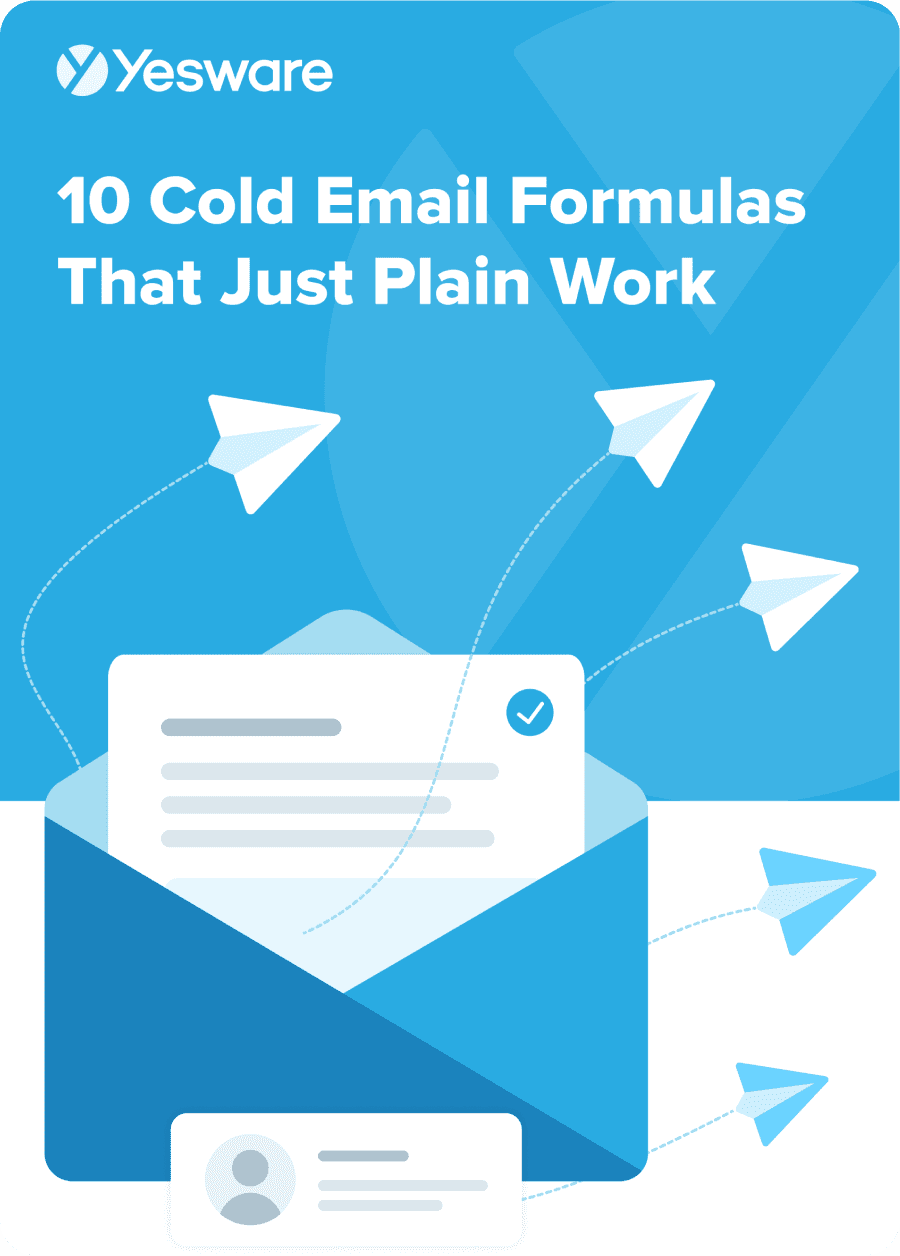 10 Cold Email Formulas That Just Plain WorkSee how B2B sales professionals are using these cold email templates to engage more prospects, fill the top of their funnel and build more sales pipeline faster.
10 Cold Email Formulas That Just Plain WorkSee how B2B sales professionals are using these cold email templates to engage more prospects, fill the top of their funnel and build more sales pipeline faster.
Following Up
Don’t give up if you don’t hear back from your initial email outreach.
With every follow-up email, you should continue to demonstrate the value that you can provide. But remember, never send a follow-up email without a piece of value.
Although many sales reps feel like they’re being too pushy by sending consistent follow-ups, every email you send increases your chances of getting a response.
In a follow-up email statistics study conducted by Yesware, we looked at ten million email threads to dissect the optimal number of follow-ups as well as how long you should wait in between each email.
We found that the most successful cadence is six touches in the span of roughly three weeks. Here’s the data below:
 The chart shows that you should spread your follow-ups out by roughly three to four days.
The chart shows that you should spread your follow-ups out by roughly three to four days.
- Follow-up #1: 3 days
- Follow-up #2: 7 days
- Follow-up #3: 11 days
- Follow-up #4: 15 days
- Follow-up #5: 19 days
- Follow-up #6: 22 days
Tip: Here are some successful follow-up email templates.
Email Outreach Best Practices
1. Incorporate Social Proof
When receiving a cold email, recipients are most likely thinking, “should I respond to this message from a person I’ve never heard of before?” The best way to make that decision less risky is to include social proof.
When consumers are uncertain about a purchase, they look to the behaviors and actions of others to help determine their own.
How to use social proof in your email outreach:
- Mention well-known companies that use your product or service
- Share the results your customers have achieved with your solution
- Showcase strong numbers and ROI stats
Reference Specific Pain Points
Another great way to personalize your message and show you’ve done your research is to reference specific pain points.

The example below calls out a pain point that was found through the company’s career page. The email addresses the pain point then offers a more immediate solution than a new hire.

2. Use Strong Personalization
Sending personalized emails is a highly effective way of increasing email engagement. And in 2022, you should never send an email that’s not personalized to a specific lead and company.
Here are some of the most powerful ways to personalize your emails that we’ve found throughout our email studies.
- Highlight mutual connections
- Use their name more than once
- Reference pieces of information found in your research
- Use trigger events to get your foot in the door
- Personalize with praise
- Provide information that is beneficial to their specific role
3. Paint a Picture
Try the Before-After-Bridge (BAB) formula for your cold emails.
Before — Here’s your world now.
After — Imagine what the world would be like if you solved this problem.
Bridge — Here’s how to get there.

First, describe a problem that is relevant to your recipient. Second, describe how the world would be different if that problem didn’t exist. And third, explain how your solution can help them get there.
This works because humans are motivated to take action by pleasure and pain. This formula ties both together to paint a picture and elicit a response.
4. Send Your Emails at the Right Time
According to a study conducted by Yesware, the best time to send email based on reply rates is 1 PM. And the second-best time is 11 AM.
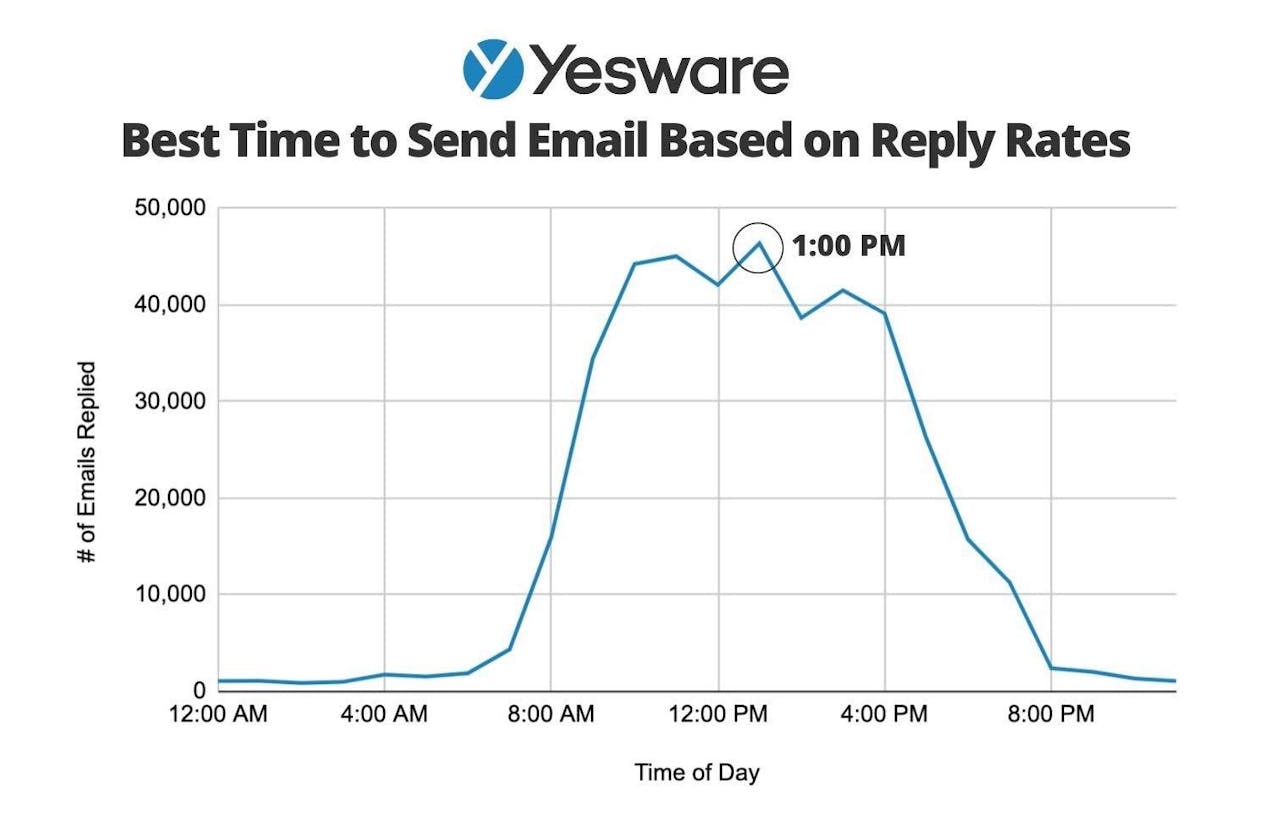
The data shows that your ideal time blocks for email outreach are 1-3 PM and 9-11 AM.
Although every audience is different, and we recommend you test the timing of your email outreach yourself, this data can help steer you in the right direction.
5. Find Uncommon Commonalities
Countless psychology studies show that we are more likely to trust people who are similar to us. This perceived similarity increases liking, even if you don’t actually know the person.
You can find these similarities by checking your recipient’s LinkedIn, Twitter, Facebook, and other public profiles to find similar backgrounds, hobbies, likes, dislikes, etc.
And because most sales reps are doing this, try to find something that’s not particularly common. This could be the leg up you need to get a response from someone who might otherwise ignore you.
Here’s an example:

6. Provide Value
A powerful tactic for warming up cold leads is using The Power of Reciprocity. It’s an intuitive human condition to feel that you owe something to someone who has provided you helpful insight and value.
If you focus on helping them, the return will come naturally.
Here are some ways of doing so:
- Invite them to a conference or event
- Introduce a business connection
- Introduce a potential candidate if they’re hiring
- Send them a research brief or relevant article
- Give helpful industry-specific advice
There are many ways you can warm up leads, but the most important thing to keep in mind is to focus on helping them rather than pushing them.
Be kind to the recipient, and most of the time, you can expect them to be kind back.
7. Be Different
With the influx of emails sent and received every day, one of our most crucial email outreach tips is to be different.
Consumers today crave a human connection – show your personality and connect with the recipient on a personal level.
Tip: Sales Outreach Management Guide
Email Outreach Mistakes
Here are some crucial email outreach mistakes that you should avoid at all costs.
1. Hiding Key Elements in Long Text
It’s easy to get carried away when writing emails, but it’s important to make sure you’re not smothering the key elements in your message.
To make it easier for your recipient to find the main points of your message, use bulleted lists to help them easily digest the information.
And if they’re skimming your message, they will still gather important pieces of information before clicking away.
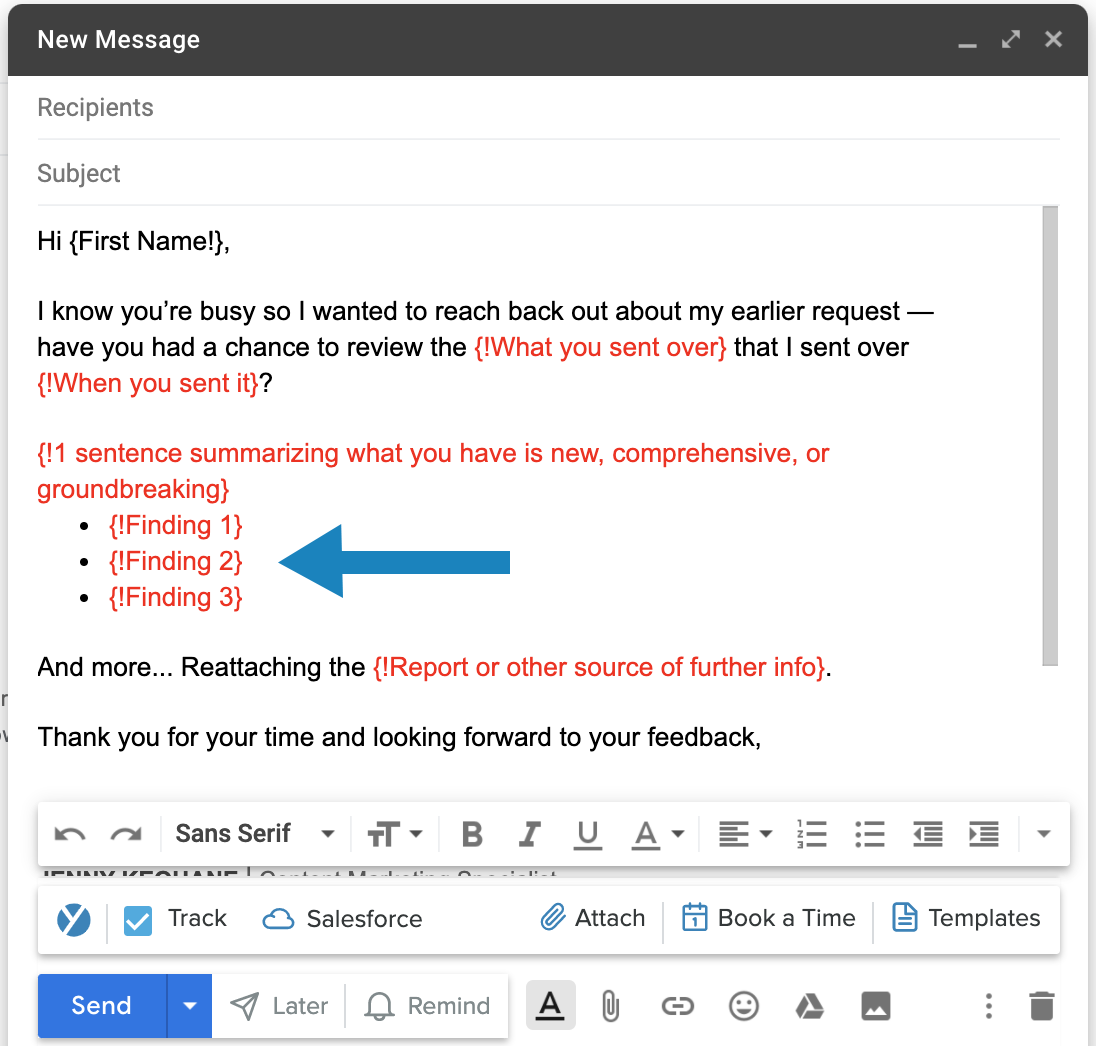
2. You’re Flagging Spam
Internet service providers and email services will automatically block emails they detect as spam, but the filtering process isn’t perfect. And some common mistakes can cause your email to get tossed into the void.
Here are some reasons your emails are going to spam:
- You have low engagement rates
- You’re not updating and cleaning your email lists
- There are all caps or multiple exclamation points in your subject lines
- You’re using various font styles and colors in your emails
- You’re sending unsolicited attachments
- There are spam trigger words in your subject line/email
With spam filters becoming more refined, it’s important to stay on top of up-to-date patterns and keep an eye on your email deliverability.
3. Not Addressing The Recipient By Their Name
This goes without saying; greeting your recipient with “Hi there” shows you’ve done 0 research, and they will most likely assume this is a mass email sent out to hundreds of people.
Personalization is fundamental in all email outreach. And countless studies demonstrate this.

4. Not Experimenting and Tracking The Success of Your Email Outreach
When you’re sending email outreach, it’s crucial to have a tool that tracks your emails, so you know what is/isn’t working. It’s also beneficial to experiment with different methods and outreach techniques to figure out what resonates with your specific audience.
A tool like Yesware will show you exactly when recipients open your emails, how they interact, which messaging is most effective, and which content is most engaging.
![]()
You can use this information to edit your emails accordingly. If you’re getting opens but not responses, your subject line resonated with the recipient, but your message didn’t. If you’re getting link clicks and attachment opens, your message resonated with them, but the content needs more work. You get the point.
Use the power of technology to improve your outreach and gauge what’s resonating with your recipients and what needs more work.
5. Not Following Up
As discussed above, follow-ups are essential in sales. Each time you follow up, you increase your chances of getting a response.
According to a study conducted by Yesware, if you don’t receive a reply to your first email, you have a 21% chance of getting a reply to the second one. And although the percentage decreases with each follow-up, you create more opportunities for your recipient to reply with each email.
After that second follow-up, there is still a 25% chance you will eventually hear back from the recipient.

Although we don’t recommend continuing all the way to 10 follow-ups, the chart ultimately shows that it pays to follow up. And the number of follow-ups depends on your specific outreach strategy.
Email Outreach Tools
There are various tools to help make your email outreach easier.
1. Hunter
Hunter helps you find and verify email addresses in seconds for your outreach. Punch any company domain name in and you’ll quickly get a list of all publicly available email addresses associated with it.

2. Yesware
Yesware lets you save frequently used emails as templates and personalize emails at scale so you can reach more buyers in less time. The tool identifies what messages are working and what are not with robust reporting capabilities so you can continuously improve your outreach.

3. Grammarly
Grammarly never lets you send an email with a spelling mistake. As you type, the tool will quickly catch errors and mistakes so that you’re always clicking send with confidence.
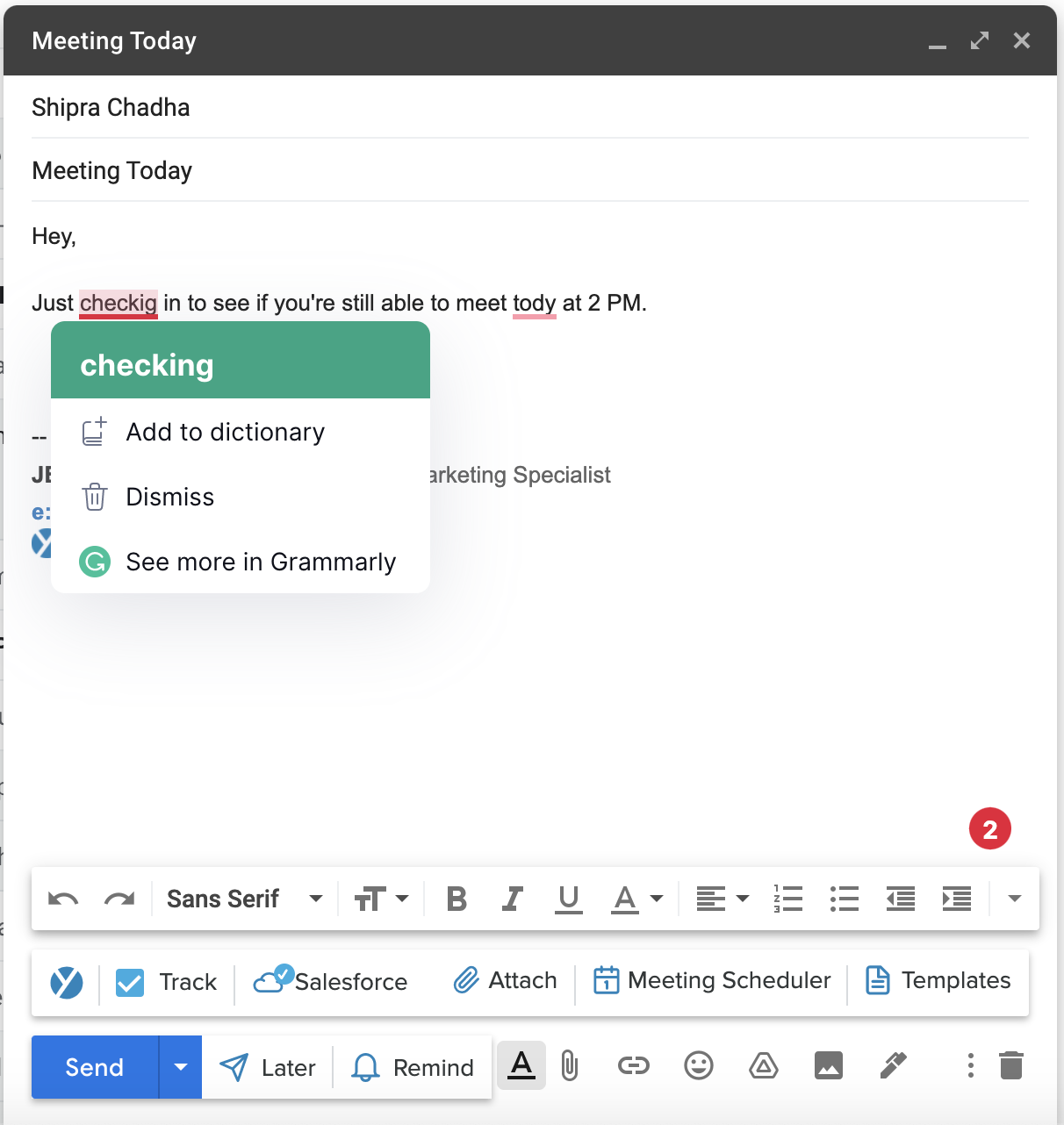
Conclusion
Email outreach can be an extremely beneficial sales technique that generates tangible results.
Whether you’re just getting started or are an outbound sales veteran, we hope this guide identifies some worthwhile strategies for you to test out yourself.
Keep testing new messaging, new send times, and cadences to gauge what works the best for your particular audience. And continue to measure the success of your outreach so you can keep improving.
Get sales tips and strategies delivered straight to your inbox.
Yesware will help you generate more sales right from your inbox. Try our Outlook add-on or Gmail Chrome extension for free, forever!
Related Articles
Jenny Keohane
Jenny Keohane
Melissa Williams
Sales, deal management, and communication tips for your inbox
